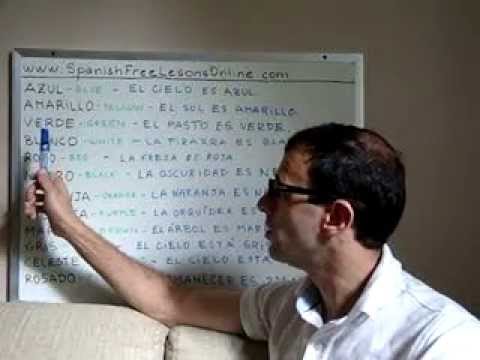SPANISH COLORS
Today lets start learning the names of the Spanish colors.
Colors are adjectives. And as such, their ending changes depending on whether they refer to a singular noun or to a plural noun.
Generally speaking, if the color or adjective ends in “o” or “a”, then the ending also changes according to the noun it refers to: masculine or feminine; singular or plural.
Thus, Spanish colors may generally end according to the noun the refer to in:
- o – masculine singular
- a – feminine singular
- os – masculine plural
- as – feminine plural
However, this is not so with colors that don’t end in either “a” or “o”. I will show you that with some few examples, so it becomes crystal clear to everyone:
A few Spanish colors:
- azul – blue
- amarillo – yellow
- verde – green
- blanco – white
- rojo – red
- negro – black
- naranja – orange
- violeta – violet
- marrón – brown
- gris – grey
- celeste – baby blue
- rosa – pink
Now I will attach these Spanish colors to a few nouns so you can see how the ending may change or not. I will use masculine, feminine, singular and plural nouns.
Spanish nouns to use:
- el edificio – the building
- la casa – the house
- los edificios – the buildings
- las casas – the houses
Now lets attach the Spanish colors to the Spanish nouns:
- el edificio azul
- la casa azul
- los edificios azules
- las casas azules
- el edificio amarillo
- la casa amarilla
- los edificios amarillos
- las casas amarillas
- el edificio verde
- la casa verde
- los edificios verdes
- las casas verdes
- el edificio blanco
- la casa blanca
- los edificios blancos
- las casas blancas
- el edificio rojo
- la casa roja
- los edificios rojos
- las casas rojas
- el edificio negro
- la casa negra
- los edificios negros
- las casas negras
- el edificio naranja
- la casa naranja
- los edificios naranja
- las casas naranja
- el edificio violeta
- la casa violeta
- los edificios violetas
- las casas violetas
- el edificio marrón
- la casa marrón
- los edificios marrones
- las casas marrones
- el edificio gris
- la casa gris
- los edificios grises
- las casas grises
- el edificio celeste
- la casa celeste
- los edificios celestes
- las casas celestes
- el edificio rosa
- la casa rosa
- los edificios rosa
- las casas rosa
Note how the exceptions to the rule I mentioned above are the Spanish colors “naranja“, “rosa” and “violeta“.
So, what is different about these 3 colors, and why do they behave differently? Here the reason:
NARANJA, ROSA and VIOLETA are not originally Spanish colors. Rather, they are names of fruits and flowers that later became colors. Therefore, these adjectives don’t modify their endings like most other adjectives.
In the case of VIOLETA, it’s accepted to add an “s” for the ending. But it’s not needed.
For orange and pink we usually say “anaranjado” and “rosado”. This way these two noun-colors become real adjectives, thus changing their ending to “o”, “a”, “os” and “as” like most other adjectives.
I recommend all my students that follow my online courses to do the exams that I upload to my website. The topic of this lesson (Spanish colors) is included in Spanish Quiz Nbr. 5 (lessons 27 – 34).
You can find a full list of all the video lessons by clicking on the List of Lessons tab on the Main Menu.
To enlarge the video-screen to full-size, click on the right icon on the lower right corner of the video.













